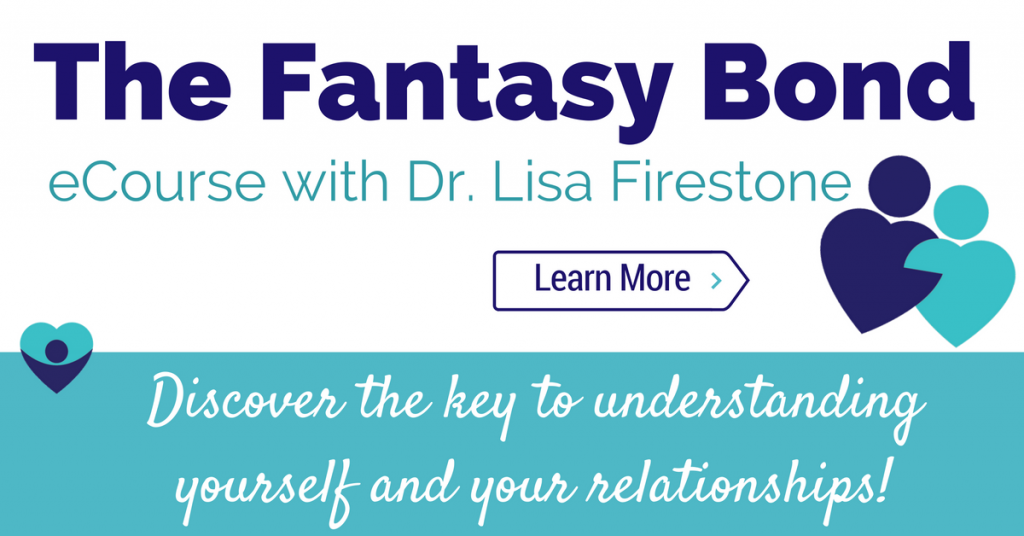 Defenses formed in childhood hurt adult relationships.
Defenses formed in childhood hurt adult relationships.
Most people have fears of intimacy and are self-protective and at the same time are terrified of being alone. Their solution to their emotional dilemma is to form a fantasy bond. This illusion of connection and closeness allows them to maintain an imagination of love and loving while preserving emotional distance. Destructive fantasy bonds, which exist in a large majority of relationships, greatly reduce the possibility couples achieving intimacy.
The nature of a fantasy bond is the central concept of my theory as explained in my book The Fantasy Bond. It explains people’s compulsion to relive the past with new relationships i.e., to form illusory connections that invariably lead to a reenactment of defensive styles of interacting developed in childhood. This process of reverting to outmoded defense patterns interferes with the establishment of secure and satisfying adult relationships characterized by feelings of humanity, compassion, and equality. Once a fantasy bond is formed, individuals prefer to maintain a defensive posture rather than trusting and investing genuine feeing in others. Once having been hurt, they are reluctant to take a chance again and this defensive pattern has an insidious effect on couple and family relations.
Men and women are most likely to become romantically involved at a stage in their lives where they are breaking dependent emotional ties with their families and experiencing a sense of separateness and independence. As they reach out and risk more of themselves emotionally, they tend to attract others with their vitality and enthusiasm. In the first stages of the relationship, they tend to let down their defenses and are open and vulnerable.
While this state of being in love is volatile and exciting, at the same time it can be frightening. The fear of loss or abandonment as well as the poignant sadness often evoked by positive emotions may become difficult to tolerate, especially for those who have suffered from a lack of love in their early lives. At the point these individuals begin to feel anxious or frightened, they retreat from feeling close, gradually giving up the most valued aspects of their relationships, forming a fantasy bond.
By the time most people reach adulthood, they have solidified their defenses and exist in a psychological equilibrium that they do not wish to disturb. Although they may be relatively congenial with more casual acquaintances, there is a deterioration in friendly and respectful feelings as a relationship becomes more meaningful and intimate, because the new love object now threatens to disrupt this balance by penetrating their basic defenses.
A fantasy bond is the antithesis of a healthy personal relationship where individuals are free to express their real feelings and desires. This destructive tie functions to perpetuate feelings of distrust, self-hating thought processes, and the inward behavior patterns that each person brings to the relationship. In their destructive coupling, men and women surrender their unique points of view for an illusion of safety.
Perhaps the most significant sign that a fantasy bond has been formed is when one or both partners give up vital areas of personal interest, their unique points of view and opinions, their individuality, to become a unit, a whole. The attempt to find security in an illusion of merging with another leads to an insidious and progressive loss of identity in each person. The individuals involved learn to rely more and more on habitual contact, with less and less personal feeling. They find life increasingly hollow and empty as they give up more aspects of their personalities.
There are a number of steps that individual partners can initiate to break into the fantasy bond they have formed with each other. Partners can:
(1) admit the existence of a fantasy bond. Stop denying that they have become distant and their actions are no longer loving
(2) reveal feelings of anger, hostility, and withholding patterns and admit critical, hostile attitudes toward themselves and their partner
(3) face the psychological pain and sadness involved in attempting to reestablish intimacy
(4) expose their fears of individuation and separation, including the fear of loss or death of their partner as well as their own death
(5) move toward independence and respect for each other and establish true equality. Disrupt reciprocal patterns of dominance, submission, and defiance
(6) develop a non-defensive posture toward feedback and an open and honest style of communication
(7) move toward increased interaction with others–extend circle of family and friends to provide better reality testing
Positive change takes place only when the fantasy bond in the original family is investigated and its reestablishment is challenged in the current relationship. As fantasy bonds were understood and relinquished, the individuals in a relationship manifest new energy, self-possession, and vitality and are able to become loving companions and allies.


